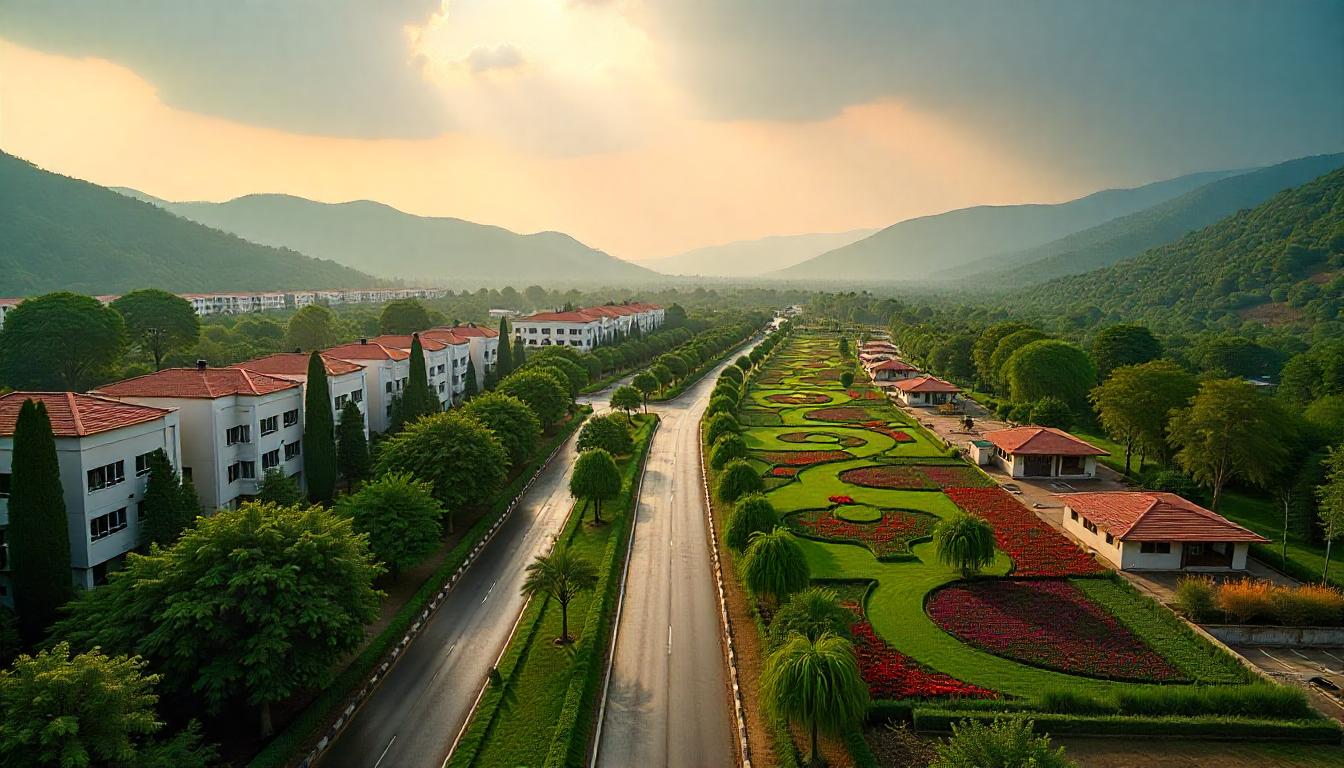
Blog
We keep you up to date on the most recent real estate news and events.
How Proximity to Nature Enhances Real Estate Value in Emerging Cities
The New Dawn of Nature-Led Living in India
The COVID-19 pandemic reshaped the way Indians perceive their homes. No longer just a shelter, a home has become a sanctuary, a space for wellness, tranquility, and connection with the environment. According to a 2024 Knight Frank report, the luxury housing segment in India’s top cities saw significant growth, with homes priced above ₹1 crore accounting for 41% of residential sales, as buyers prioritize spacious, nature-oriented properties over urban density. This seismic shift towards wellness-driven living has propelled emerging cities into the spotlight, where natural surroundings offer a rare blend of serenity and investment potential.
Among these, Panchkula, nestled at the foothills of the Shivalik Hills, stands out as a beacon of nature-led luxury living. With its proximity to the Morni Hills, lush forest reserves, and some of North India’s cleanest air, Panchkula is redefining real estate value in 2025.
But what makes proximity to nature such a powerful driver of property appreciation, and why is Panchkula emerging as a prime destination for HNIs, NRIs, and upwardly mobile families? This article explores the growing allure of nature-centric real estate in India’s tier-2 and tier-3 cities. We’ll uncover how green surroundings are reshaping buyer preferences and driving premium property values in emerging urban hubs.
The Rise of Nature-Led Homebuying in India
The Indian real estate market is undergoing a profound transformation, catalyzed by post-pandemic shifts in lifestyle priorities. The wellness boom, as highlighted in a 2024 CBRE report, has seen luxury home sales priced above ₹4 crore surge by 75% in 2023, with buyers gravitating towards properties that integrate natural elements and sustainable design. This trend, often termed biophilic design, emphasizes a connection to nature through green spaces, natural light, and eco-friendly infrastructure. Buyers are no longer content with concrete jungles; they seek homes that foster physical and mental well-being.
The demand for nature-led living is particularly pronounced in tier-2 and tier-3 cities, where affordability, improved connectivity, and proximity to natural landscapes create a compelling value proposition. According to a 2025 CREDAI-Liases Foras report, 44% of the 3,294 acres of land acquired by developers in 2024 were in tier-2 and tier-3 cities, reflecting a strategic pivot towards markets like Coimbatore, Indore, and Panchkula. These cities offer a respite from the congestion of metros like Mumbai and Delhi, blending modern amenities with serene environments. The post-COVID emphasis on wellness has also spurred interest in green mobility like cycle lanes, pedestrian-friendly townships, and low-emission infrastructure, further enhancing the appeal of these locales.
Why Proximity to Nature Matters
The correlation between proximity to nature and real estate value is well-documented globally and increasingly evident in India. A 2024 Cushman & Wakefield report notes that properties with access to green spaces or natural views in India’s urban areas can command a price premium of up to 10%, particularly in tier-2 cities. This is driven by both emotional and practical factors: green surroundings improve air quality, reduce stress, and enhance livability, while also serving as a hedge against urban sprawl.
The Central Pollution Control Board (CPCB) highlights that cities with high green cover and low Air Quality Index (AQI) levels are increasingly sought after by health-conscious buyers. For instance, homes in areas with an AQI below 100—considered ‘good’ by WHO standards—are perceived as premium assets, especially post-COVID. This is where emerging cities shine, offering cleaner air and natural beauty without sacrificing connectivity or infrastructure. The Ministry of Housing and Urban Affairs (MoHUA) further supports this trend through initiatives like the Smart Cities Mission, which prioritizes sustainable urban planning and green infrastructure in tier-2 hubs.
Panchkula: A Jewel in North India’s Real Estate Crown
Nestled in Haryana, Panchkula is rapidly emerging as a hotspot for nature-led luxury living. Its strategic location at the foothills of the Shivalik Hills, coupled with proximity to the Morni Hills and the Khol-Hai-Raitan Wildlife Sanctuary, offers an unparalleled blend of natural beauty and urban accessibility. Just a 20-minute drive from Chandigarh and a few hours from Delhi, Panchkula is a haven for those seeking a balanced lifestyle without compromising on connectivity.
The Shivalik Hills: A Natural Backdrop
The Shivalik Hills, forming the northern boundary of Panchkula, provide a stunning backdrop of rolling greenery and biodiversity. This range, part of the Himalayan foothills, is home to diverse flora and fauna, making it a magnet for eco-conscious buyers. Properties with Shivalik views command significant premiums, with a 2024 ANAROCK report noting that homes in Panchkula’s premium sectors saw a 7–9% price increase between 2023 and 2024 due to their scenic appeal and proximity to natural landscapes. The hills also moderate the city’s microclimate, ensuring milder summers and cleaner air compared to nearby metros.
Morni Hills and Forest Reserves
The Morni Hills, a short drive from Panchkula, are a hidden gem known for their lush forests, trekking trails, and serene lakes. The Khol-Hai-Raitan Wildlife Sanctuary, a protected area, further enhances the region’s ecological appeal. According to IQAir, Panchkula’s AQI averages around 50–100, among the lowest in North India, making it a standout for buyers prioritizing clean air. The CPCB confirms that the city’s green cover, estimated at over 30% of its total area, contributes significantly to its air quality, attracting HNIs and NRIs seeking second homes or retirement retreats.
Sukhna Lake: A Recreational Haven
Sukhna Lake, located on the Chandigarh-Panchkula border, is a recreational and ecological asset that boosts property values in the region. Homes near the lake are highly sought after, with a 2024 CBRE report noting a 7–10% price premium for lake-facing properties in the Tricity area. The lake’s walking trails, birdwatching opportunities, and water sports facilities make it a focal point for wellness-oriented lifestyles, aligning with the post-COVID demand for nature-integrated living.
Panchkula’s Appeal to Diverse Buyers
Panchkula’s natural endowments make it a magnet for a diverse buyer demographic. HNIs and NRIs, drawn by the promise of serene second homes, are increasingly investing in the region. A 2024 Colliers report projects that NRI investments in Indian real estate, particularly in tier-2 cities like Panchkula, are expected to grow by 80% in 2024–25, driven by favorable government policies and the region’s affordability compared to global markets. The city’s proximity to Chandigarh’s IT and business hubs also attracts young professionals and families relocating from Delhi and Gurgaon, seeking affordability and quality of life.
Trident Hills, a RERA-approved, 200-acre township, epitomizes India’s shift toward sustainable luxury. With solar-powered villas, 5 km of forested trails, and a 50,000 sq. ft. clubhouse, it merges eco-conscious design (70% open spaces) with Chandigarh’s urban pulse. Its RERA-backed transparency has driven 90%+ plot sales within 18 months of launch, setting a benchmark for investor trust in the Tricity region.
Comparing Panchkula with Other Emerging Cities
While Panchkula shines, other tier-2 cities like Dehradun, Kasauli, and Coimbatore are also capitalizing on their natural surroundings. Dehradun, nestled in the Doon Valley, has seen a 12% year-on-year increase in luxury home sales, driven by its proximity to the Himalayas and Mussoorie’s hill stations. Kasauli, another Himalayan gem, attracts buyers with its colonial charm and pristine forests, though its smaller size limits large-scale township development. Coimbatore, in South India, leverages its proximity to the Western Ghats and a robust industrial ecosystem, with a 2024 Knight Frank report noting an 8–10% price appreciation for nature-facing homes.
Panchkula stands out for its unique combination of natural assets, strategic location, and infrastructure growth. Unlike Dehradun, which faces land scarcity, or Kasauli, with limited urban amenities, Panchkula offers a balanced ecosystem. Its inclusion in the Smart Cities Mission, coupled with projects like the Chandigarh Metro extension, enhances its connectivity, making it a more accessible choice for buyers.
Wellness Boom and Luxury Housing Narrative
The post-COVID wellness boom has fundamentally altered India’s luxury housing narrative. Buyers now prioritize homes that support mental and physical health, with features like biophilic design, green roofs, and smart ventilation systems becoming standard. A 2025 Cushman & Wakefield report notes that 80% of luxury homebuyers in India seek properties with sustainable features, such as solar power and rainwater harvesting, aligning with global trends like the WELL Building Standard. This standard, which emphasizes health-focused design, is gaining traction in premium developments across India.
In Panchkula, developers are responding by integrating wellness-centric amenities into townships. Smart homes with IoT-enabled climate control, community gardens, and walking trails are increasingly common, reflecting the broader shift towards eco-conscious living. The Smart Cities Mission further supports this by promoting green infrastructure, such as cycle lanes and urban forests, which enhance property appeal.
Nature and Property Appreciation
The link between nature and property value is quantifiable. A 2024 CBRE report found that homes in Indian cities with high green cover command a 7–12% price premium, with tier-2 cities like Panchkula at the higher end of this range. Globally, a 2021 study by the Urban Institute noted that proximity to parks or forests increases property values by 8–20%, depending on urban density. In Panchkula, this is evident in areas like Sector 20 and the MDC sectors, where apartments with Shivalik or lake views have appreciated by 7–9% annually, per a 2024 ANAROCK report.
The clean air factor is equally critical. According to IQAir, Panchkula’s AQI of 50–100 contrasts sharply with Delhi’s 150–250, driving demand from health-conscious buyers. The CPCB’s 2024 air quality report underscores that cities with low AQI and high green cover see faster real estate appreciation, as buyers perceive these areas as long-term investments in health and lifestyle. This is particularly relevant for NRIs, who, per a 2024 Colliers survey, expect to increase investments in wellness-oriented properties by 80% in 2024–25.
Challenges and Opportunities in Emerging Cities
Despite the promise of nature-led real estate, challenges persist. Regulatory hurdles, such as delays in RERA approvals, can slow project timelines, though Panchkula benefits from Haryana’s streamlined processes. Opportunities, however, abound. The Smart Cities Mission and PM GatiShakti initiatives are enhancing connectivity, with projects like the Panchkula-Chandigarh Metro set to boost accessibility. The growing presence of IT and manufacturing hubs in nearby Chandigarh further drives demand for premium homes, positioning Panchkula as a satellite city with metro-like potential. Developers are capitalising on this by launching integrated townships that blend nature with modern amenities, ensuring long-term value appreciation.
Conclusion: Panchkula’s Bright Future in Nature-Led Luxury
As India’s real estate market evolves, proximity to nature has emerged as a defining factor in property value. Panchkula, with its Shivalik Hills, Morni Hills, and pristine air quality, exemplifies this trend, offering a rare blend of wellness, luxury, and investment potential. Its appeal to HNIs, NRIs, and young professionals underscores its status as a standout among tier-2 cities, rivalled only by hubs like Dehradun and Coimbatore. Backed by robust infrastructure growth and government initiatives like RERA and the Smart Cities Mission, Panchkula is poised to lead North India’s real estate renaissance.
For buyers seeking a home that marries nature with modern living, Panchkula offers an unmatched proposition. Townships like Trident Hills, with their focus on green spaces and wellness amenities, reflect the future of luxury living in India—a future where the call of the wild meets the comforts of home. As the wellness boom continues to reshape buyer preferences, Panchkula’s natural endowments will only grow in value, making it a wise choice for investors and homeowners alike in 2025 and beyond.